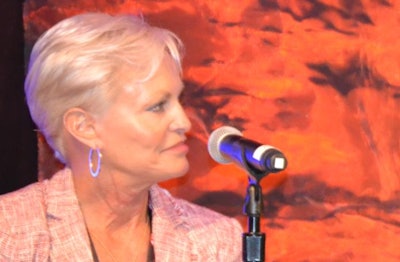
The animal rights lobby and the National Rifle Association may not seem to have much in common, but a former executive with Tyson Foods sees a striking similarity.
Both camps have an agenda they are pushing to implement change, and both have used the same tactics in order to initiate change.
Sara Lilygren, who served as Tyson Foods’ executive vice president of corporate affairs until her recent retirement, addressed that similarity on July 17 during a panel discussion at the Chicken Marketing Summit in Asheville, North Carolina.
Having had a leadership role within a company that operates in the chicken, pork, turkey and beef industries, Lilygren had witnessed the work of animal rights activists. For part of the time, the activists were not tremendously successful. That has since changed, as their desires to get cages out of egg production and gestation crates out of pork production are becoming realities.
“They’re much more successful now that they’ve taken a page out of the book that National Rifle Association (NRA) and other grassroots organizations have used successfully, and that page is organize at the state level and pass state laws in states that don’t care that much about the issue,” explained Lilygren.
“After you’ve got 9, 10, 11, 12 states that has passed laws, all of the sudden you will bring the industry to its knees, because suddenly the industry players in 36 states have one set of rules and the industry players in the other 14 states have another set of rules. All of the sudden there is inequity in the industry, and then you’ve got them on their knees.”
Consumers not being targeted
While policy changes, whether related to animal agriculture or gun issues, should be made with the input of the general public considered, that isn’t always what happens.
Lilygren said the animal rights lobby went straight to decision-makers rather than the consumers who buy the eggs and/or pork products.
“This is what was interesting to me. Consumers weren’t the audience,” said Lilygren. “It was policymakers who didn’t want to be shamed in one way or another or blackmailed, or embarrassed. Or in some cases, it was big retail and foodservice companies who didn’t want to be shamed or blackmailed or embarrassed.”
Lilygren said in the case of gestation crates: “Consumers didn’t know what it was or didn’t even care about it.”
But retailers who sell those products do, and for a lot of different reasons.
“Some reasons were, ‘because my wife thinks it’s a big deal and I want to make a decision for my company.’ Some of it was, ‘my competitors made a decision, so I guess I need to do it too or I’m going to look like I’m a Neanderthal,’” Lilygren said.
It’s the smaller audience that makes a difference
Lilygren said that in the animal welfare space, the audience that usually can make a difference is a small one. But it is also a group of people that have more power to become agents of change.
Those people that can make a difference are motivated by a variety of things, including those who sell and market pork and poultry products. The animal agriculture community must reach out to those decision-makers so arrangements can be made that will be beneficial.
“We need to get closer to our customers longer in front of the issues that trouble us and figure out how we are going to come up with innovative solutions to challenges,” Lilygren said. Then we can erase black clouds of doubt.”
Chicken Marketing Summit 2018
Chicken Marketing Summit uniquely explores issues and trends in food marketing and consumer chicken consumption patterns and purchasing behavior. In addition to educational sessions, attendees have numerous networking opportunities to foster interaction between speakers and fellow poultry industry peers. Chicken Marketing Summit 2018 will take place at the Four Seasons Resort Orlando at Disney World in Orlando, Florida, USA on July 22 -24, 2018.

















